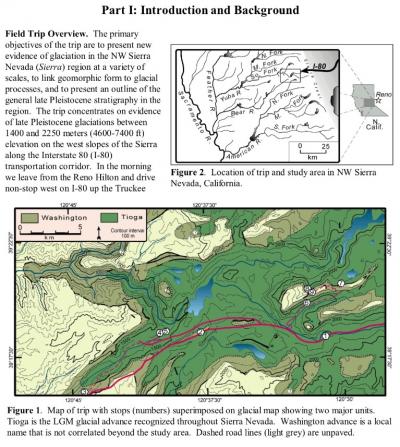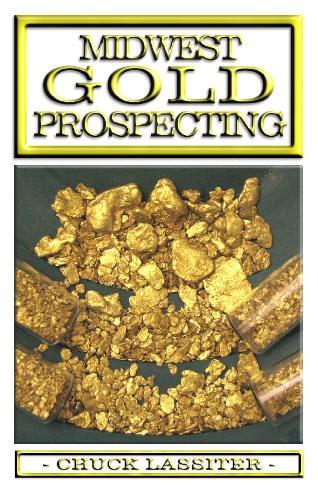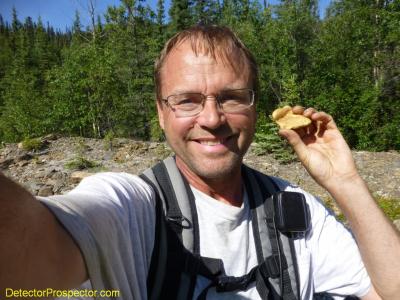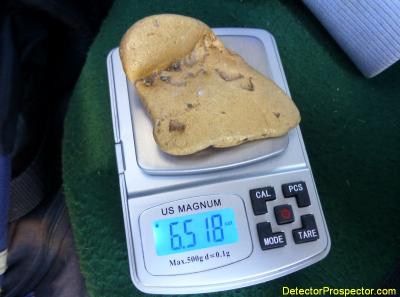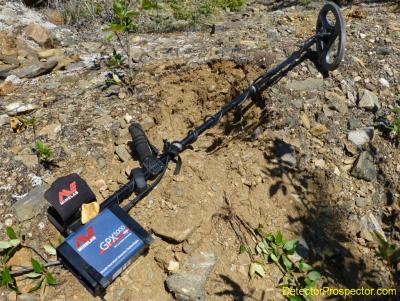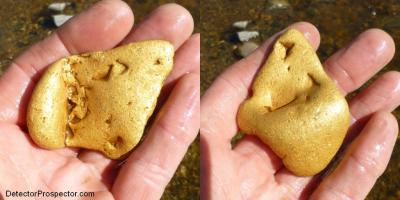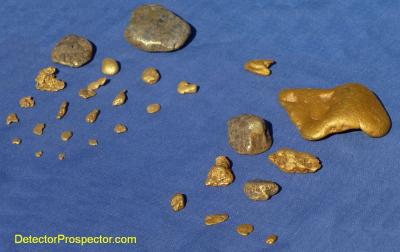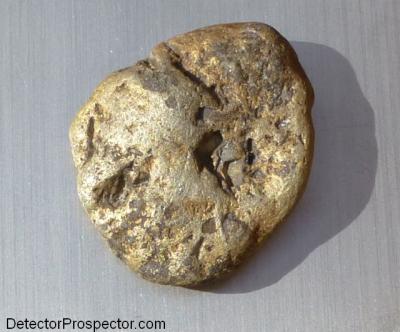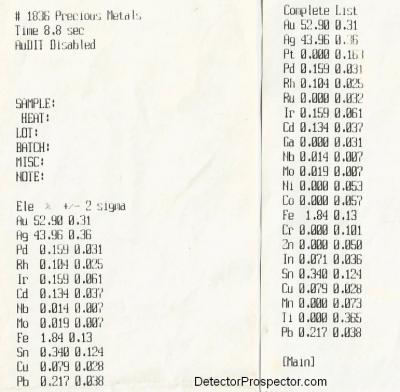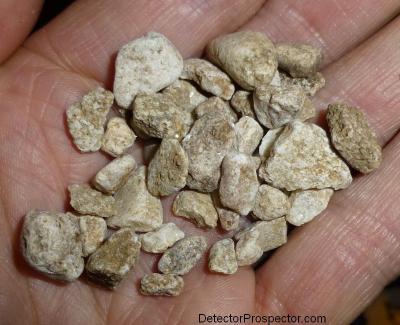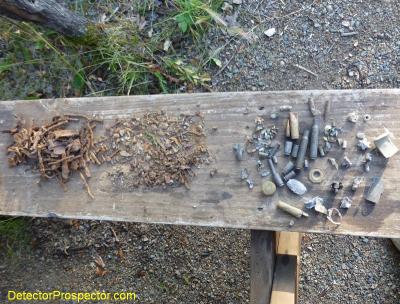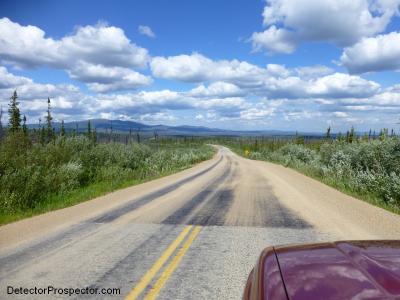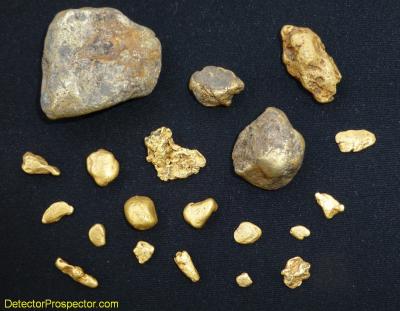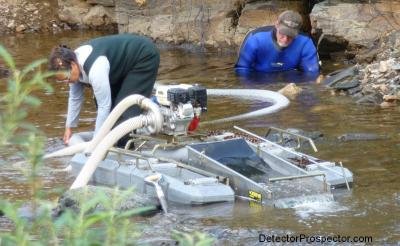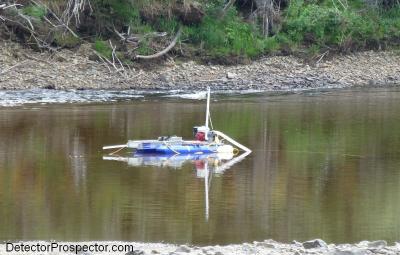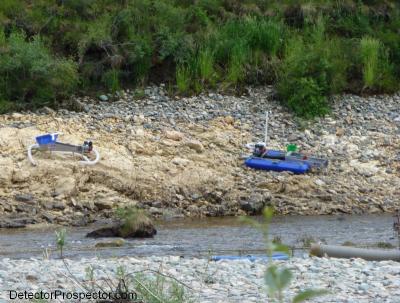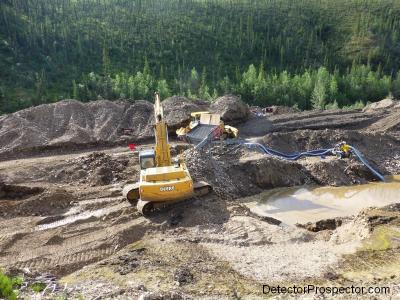-
Posts
19,753 -
Joined
Content Type
Forums
Detector Prospector Home
Detector Database
Downloads
Everything posted by Steve Herschbach
-
Well, it can all be useful in different way, not least just in keeping ourselves entertained! Tom, bricks can and have been used to simulate mineralized ground, but again the key word here is simulate. I can set up a situation where two of exactly the same detector has one that air tests far better than the other, only to have the result switch 180% degrees in the ground. A detector air testing better than another, even the same model, does not automatically mean it will detect deeper in the ground. I do not know how to say it any plainer than that. Most of the time, yes, but not always. I do most of my work with ground balancing PI detectors, and to remove the ground from the test equation is removing the sole thing that really matters. A non ground balancing PI will kill a ground bslancing PI in most air tests. A horribly mis-balanced VLF can outperform the same properly ground balanced VLF in an air test also. Having said that, I very much admit I do lots of air tests. They have there uses. But right now I have several things on hold pending true in ground tests as that is the only way I can find out for sure what is going to work best for me. Great subject actually, backed by a lot of "beliefs". Be a good subject for a study with a video. There are several very good studies done if you do some Googling on the testing on mine detectors in mineralized ground. Would post the myself but I have a meeting to catch! The real point I am making is question everything others do, especially as regards air tests and even in ground tests, and even in videos. If I do not do the testing myself I have no idea really, and even then I can mislead myself if I am not careful.
-

Ideas For Changing Audio Tones/Sounds?
Steve Herschbach replied to ~LARGO~'s topic in Metal Detector Advice & Comparisons
The funny thing is some people just love that fluty sound! Signal processing is where it is at for sure. The best detectorists hunt by ear, and they are discerning things that good software should be able to emulate. I think that is where Minelab maintains their edge with the FBS detectors. A lot going on in software there. Anyone that can tell the difference between lead and gold with a detector is a far better detectorist than I am! -
Good post Tom! Suction dredges are relatively inefficient recovery devices and can lose substantial amounts of gold for many reasons. I am sure I have personally pumped ounces of gold off the end of dredge sluice boxes over the years with the sheer hours of dredging I put in under adverse conditions. One memorable event was when I had my box load up with rotten shale I was hogging too fast. It just sort of laid down over the riffles like roofing shingles. I went back and looked at the tailing pile underwater and could see gold all over it. Dredged the whole thing up all over again!
-

Ideas For Changing Audio Tones/Sounds?
Steve Herschbach replied to ~LARGO~'s topic in Metal Detector Advice & Comparisons
On older units there may be an ability to vary tones internally via a pot but newer detectors it is usually done in software. Different headphones sound different to a certain degree so that can possible make a difference. I always wondered about the use of various audio plug in devices to possibly vary tone outputs but have never experimented at all with that. -
The rumor mill is cranking up fast about a possible new release from White's Electronics, the White's V4 Link deleted since Findmall Forum update broke all old links http://www.dankowskidetectors.com/discussions/read.php?2,71980 Multiple frequencies, PI mode, etc. Perhaps something taking advantage of one of White's new patents? The Half Sine patent in particular seems applicable. White's Electronics Half Sine Technology Patent White's Electronics Constant Current Technology Patent White's certainly is due for something new. Rumors are saying March/April. Looks like 2015 really might go down as the year metal detector technology made a real leap forward. But then again - it is all just rumors.
-

Glaciers & Gold
Steve Herschbach replied to Steve Herschbach's topic in Rocks, Minerals, Gems & Geology
Yeah, I like his stuff. Chris is more skeptical of portions of this one but still many good tips to be gleaned in the text and maps http://www.detectorprospector.com/forum/topic/227-free-book-the-upper-reaches-of-the-sierra-nevada-auriferous-gold-channels-california-and-nevada/ The thing is to not get bogged down the theory parts and just dig for the mentions of bits of geology here and there that might be worth prospecting. -

Glaciers & Gold
Steve Herschbach replied to Steve Herschbach's topic in Rocks, Minerals, Gems & Geology
I have to admit I have a heck of a time deciding what is old glacial material and what might be old stream material or even ancient beach deposits at times. They can grade imperceptibly from one into the other. Good news with a detector is, well, just detect the darn stuff and see what happens. Lots of people have asked me about detecting around receding glaciers in Alaska. Given the number of people who have asked me about this over the years I think it must be the idea of never before seen ground that attracts people. Other than that there is nothing in particular to recommend glacial terrain. Gold placers relay on stream action sorting and concentrating material over millennia. Glaciers are more like bulldozers pushing and stirring everything up. Gold may be there but is more likely scattered. In the case where streams have been running under or next to a glacier and in streams issuing from glaciers there can be some shorter term concentration resulting in lean placers. Ultimately it depends on there being a gold source under or in the immediate vicinity of the glacier. Lacking these there will be no gold. Since glaciers have been receding for thousands of years they have of course been prospected already, and it is not likely that simply receding another mile will all of the sudden reveal gold that was not apparent before. The long story short is prospecting glacial material might produce some gold but due to the scattered poorly sorted material such gold tends to be sparse at best. -

Glaciers & Gold
Steve Herschbach replied to Steve Herschbach's topic in Rocks, Minerals, Gems & Geology
I love observational geology. Most of the best stuff was people just like us looking at it all and applying common sense to what we see around us. It is still all a work in progress and some stuff changes as new information comes to light. Here is a newer report with lots of references that applies directly to my new backyard. Late Pleistocene Glaciations in the Northwestern Sierra Nevada http://people.cas.sc.edu/ajames/Research/Pubs/03.INQUA.Log.pdf I take a practical approach. Ages do not matter much, I just need practical information that I can use to find gold. Knowing an area was recently scoured by glaciers has a big impact on the likelihood of finding placers deposits of any sort there, even just residual placers. Those of us with detectors in particular prefer old land surfaces. But glacial deposits can hold small hidden placers, and those are very high on my interest list at the moment, which is what got me Googling away on this. -
The earth has been warming and glaciers retreating for over 15,000 years. Almost everything in the part of Alaska I lived in was recently exposed by glaciers and been prospected the last couple hundred years. Glaciers are nature's bulldozers and they destroy and mix. The gold distribution in glacial material is generally random and sparse. Where water has had time to work glacial deposits new placers can form, but the short geologic time spans we are talking about usually mean small erratic deposits. The good news is that also means you can maybe find a gold nugget just about anywhere in glacial material. If you watch the video a second time and pay attention to the area that becomes Alaska you will see that Anchorage, on the southern coast, was buried under 3000 feet of ice not too long ago. The interesting part is northern Alaska is largely ice free. This is extremely important. The placers are much older and more extensive in Interior Alaska than in the southern coastal areas. The northern US was heavily glaciated and much of the material was pushed down from out of the north in Canada. I find glacial terrain interesting because glaciers have melt water running under them and along the edges, which form small oddball placers in the strangest places, and other placers are possible in the large outwash areas. I am discovering there was a lot more glacial activity in the Sierras than I would have imagined and so this is still very relevant for me prospecting in California. These links may not be for your exact area but all contain good information about glacial geology and prospecting. Great freebie article Gold in Kansas And a small related article at the ICMJ Undiscovered Placer Deposits in Alaska Really good stuff starting page 117 on Gold Placers of Colorado Placer Deposits of the Yukon Geology of Tertiary and Quaternary Gold-Bearing Placers in the Cariboo Region, BC Here is some really technical stuff for those so inclined Glacial Geology & Prospecting Glaciers of California A much more prospector friendly version can be had in an excellent but pricey book by Chuck Lassiter, Midwest Gold Prospecting at http://www.midwestprospector.com/book.html I have a copy in my library of the best of the best. It is a high quality book with color maps and illustrations and a no-brainer at about half the cost. For $29.95 you have to just love books as much as me as that is as much as the Chris Ralph encyclopedia and this book would be a chapter in Chris book. That said, I have never seen the particular subject of glacial region prospecting covered better and more understandably anywhere else. It would be the go to primer for anyone interested in the subject.
-

Garrett ATX Strip Down & Rebuild
Steve Herschbach replied to Steve Herschbach's topic in Garrett Metal Detectors
I will have to consider that as it had not occurred to me. How would that affect operating time? I am guessing the ATX is regulated such that increasing the battery power will not affect performance but will check on that and get back to you here. There is the definite risk of blowing something. -

Steve's 2013 Alaska Gold Adventure
Steve Herschbach replied to Steve Herschbach's topic in Detector Prospector Forum
Yeah Chris, and I think we can now also appreciate just how much of a lucky fluke it was. Even a blind squirrel finds a nut now and then! Story in Reno Gazette Journal http://www.rgj.com/story/news/2015/02/19/treasure-hunt-reno-prospector/23706277/ -

Half Pounder With Cheese
Steve Herschbach replied to Steve Herschbach's topic in Minelab Metal Detectors
I don't even hope to find a nugget as big as your largest Steve. A little 12 ouncer would do me just fine! Thank guys. -
I asked Bill not long ago and he said he would find out but is of course he is very busy right now. He imagined they were available separately but had to verify it. I will find out for sure at the meeting for exactly the same reason.
-
You going to be there Ken? They really are dealer conferences but Chris Ralph and I were invited last year and this year as guests/representatives of the ICMJ. Unfortunately Chris has a conflict with a GPAA show at the same time so it is just me this year. The conference serves dealers from all over the country and even all over the world this year. A lot of it is training intended to help newer dealers get up to speed on the entire product line so it is far from being just a prospecting gig. There will probably be more dealers there wondering what Minelab has for the coin hunter than prospectors. Whatever new models there are to be released in the year are usually announced there, but the official public announcement may or may not come later. Confidentiality agreements non-withstanding Minelab does not even say anything at the meetings they really, really want kept secret, because there are dealers who tell friends who then post about it. The main benefit for me being there is to get to pick the brains of the engineers and of course I will be trying to learn as much as I can about the GPZ 7000, mainly from the aspect of how do I get the most out of it. Tips, tricks, hints, anything that might benefit me in the field. I also try and bring less knowledgeable dealers up to speed on the nugget machines if they are interested. It is all fun, just a couple solid days of metal detecting stuff. More fun for me really not being there as a dealer. Actually there is some great swag at times. I got a nice Minelab branded Camelback rucksack at the last convention that I used a lot last fall.
-
In case you have not been following the tale at Steve's 2013 Alaska Gold Adventure here is a photo from the final entry. This is the 6.5 ounce solid gold nugget I dug the summer of 2103 and kept quiet about until now for reasons explained in the tale.
-

Steve's 2013 Alaska Gold Adventure
Steve Herschbach replied to Steve Herschbach's topic in Detector Prospector Forum
Well, here we go, the grand finale! From July 22 to July 28 six days of metal detecting had netted me only three gold nuggets. That is a lot of detecting and digging for just three happy moments! I was getting burned out plus missing my wife and new home. My wife had also let me know one of my dogs was not doing well. It all just added up to time to go home. Besides, I had about 5.5 ounces of gold, not bad at all and better than I had hoped for. Good weather, good gold, good times with friends, it really had been a near perfect trip. Therefore on the morning of the 29th of July I wandered up to Chris and Bernie's camp and told them I was done. I was paid up at Chicken Gold Camp through the 31st so my plan was to be packed up and hit the road for Nevada early on August 1st. I had just a few days left so had to decide what to do. There is an area on upper Jack Wade known to have produced big gold in the past. Like nuggets weighing pounds, and a 10 ounce nugget had been found there by a dredger the previous season. It was on the ground owned by the miner I had a deal with. I had of course hunted it previously but only found a few small nuggets and lots of little ferrous trash. It was a gorgeous sunny day and the area was relatively open and level so easy hunting. I fired up the Minelab GPX 5000 with Nugget Finder 14" x 9" mono and crossed over the creek to give it a go. I was really relaxed because mentally I was done working and just happy to be out beeping a couple more days. It was really a nice feeling knowing I would soon be heading home. I barely had got started when I crested the top of a small ridge of tailings and got a massive boomer signal. Just a huge descending low tone, the type you might get if you buried a huge bolt or some other large ferrous target not too far down. There was a recent dig hole on the target, and I thought "well, let's see what he left in the hole" and gave just a couple big scoops. It was sandy easy digging stuff, and as it slid down the hill I glimpsed gold. I thought "no way!" and as I grabbed it could feel the weight. I stood there looking at 6.5 ounces of solid gold in my hand! The Selfie We All Want To Take - Steve With 6.5 Ounce Gold Nugget There is no doubt in my mind about the addictive nature of nugget detecting. It is not easy to do and the gold is not easy to find. There can be lots of false starts and disappointments along the way. It is all that however that makes it so sweet when gold is finally found, when all the hard work and effort is rewarded. I get a thrill out of every nugget I find, no matter how small, because I work hard for every one of them. The really big finds are much rarer yet, so much so that few people ever get to say they found a nugget weighing one ounce or more. The feeling of accomplishment is indescribable because it verges on feeling like a miracle has occurred. Once you get a taste of that feeling you want to feel it again, and it is that quest that powers me and others through days, months, and years of effort. The thrill of finding gold! Just Out Of the Ground, Unwashed, And On The Scale After an hour of photos and just plain soaking up the moment I proceeded to hunt that area extra well, because as you can imagine after a find like that visions of piles of nuggets enters your mind. If one got lost, might there not be others? Unfortunately it does not seem to work like that, and continued careful hunting of the location only produced one more nugget, a clean little 1 gram piece. No surprise there. How even one nugget like this gets lost is something we all wonder about. How does a half pound of solid gold end up in a tailing pile? Who knows, I am just happy it did. For a combination of size and the solid gold content it is the best nugget I have ever found. Minelab GPX 5000 With 6.5 Ounce Nugget At Dig Location The biggest question of course is who started to dig that nugget and then quit? The material was easy digging, about as easy as you could ask for. I surmise it had to be a Minelab operator. If you run a Minelab long enough you get huge boomer signals very often, and they are almost always a can or bolt or some other shallow, large junk target. They can also be very large gold nugget but if you get that signal enough times and dig it up, only to find junk, your brain gets trained to think that is all it could be. "Too big to be gold" - have you ever thought that? I wonder how many people have done like this unknown person, got a target, and then decided nope, it has to be junk, and walked away? I know I have done it and I am pretty certain it has cost me. It may be that a small percentage of the very biggest nugget signals are still out there, having been detected and left for junk. In fact, I am willing to bet that is the case, though there are a couple less now. View Of Both Sides, Just Rinsed In Creek I first went and showed the nugget to the claim owner and then Bernie and Chris. However, I asked them to keep quiet about it. The trip had been so enjoyable, and finding something like that right at the end, well, it was obvious I was going to be back in 2014. There was a lot of public area left to hunt on the creek still, and I saw no reason to possibly start a little gold rush to the area before I got the chance to come back and give it another go. That trip has now come and gone at Steve's 2014 Alaska Gold Adventure and so now finally you get to hear the rest of the story. Speaking of the public area, Bernie and I went and hit it the very next day. We had mostly taken advantage of our access to areas not available to the general public while we could and had been leaving the public area for later. There is information about it at the 2104 tale. We both started out with our GPX units but I could tell Bernie was less thrilled than I to be digging junk, so I suggested we go back to the truck and grab our VLF detectors. We did just that, and I no more than got my Gold Bug Pro swinging when it made a loud beep, and up pops a 5.9 dwt nugget practically off the surface! It was just another over the top easy nugget after all the days of digging nothing but junk. Even wilder is that fact that in 2014 several days detecting by several people including myself in this same location produced no gold at all. It is liked I walked up and banged the only nugget there. The next day and a half produced no other nuggets but I am certainly not complaining about that. My trip had gone from great to off the charts fantastic with just over a Troy pound (12 Troy ounces) of gold found. 12.3 ounces actually found in exactly 30 days of time spent actually nugget detecting. Not a get rich quick scenario by any means but not bad at all either. Overall the time spent in the Chicken area during the summer of 2013 will go down in my memory as one of my best times ever. There are many, many more photos from this trip in the Photo Gallery. Troy Pound Of Gold Nuggets From Jack Wade Creek, Alaska 2013 -

More Gold Prospecting and Rokon Porn...
Steve Herschbach replied to azblackbird's topic in Detector Prospector Forum
The following is not directed at anyone in particular. It is just sort of a policy statement for the forum, if you will. I will out myself. I think we are all responsible for trying to minimise damage to the environment as best we can while undertaking our activities. I am a responsible and environmentally concerned prospector and miner and always clean up after myself and even others. I not only abide by the rules and regulations I go beyond them whenever I can in trying to be a good steward of the land. I also try to comport myself in a professional manner when dealing with others, even those I do not agree with. Environmental harm is a very relative thing. Intense scrutiny can be placed on something like a small gold dredge, while the very same people who oppose that may be for the construction of a new freeway to shave 15 minutes off getting to work. Like many here I get angry over what I see as unfair restrictions on activities that have minimal or no impact. I have to say I get even angrier when I come across a location where a lazy prospector has left tarps, trash, and broken equipment behind. Sometimes it is hard to know who is actually causing us more harm. There should not be the perception that we as prospectors do not care about the environment and I would thank everyone to not do anything on these forums at least to feed that perception. There are more than just prospectors and miners reading. Great video, azblackbird, thanks for posting it. Rock on Rokon! Here I am with a pair of Rokons back in 1993 on a ride with my wife up the Knik Glacier floodplain, Alaska. -

Steve's 2013 Alaska Gold Adventure
Steve Herschbach replied to Steve Herschbach's topic in Detector Prospector Forum
In theory I had no deadlines on this adventure. It could go on for as long as I wanted to have at it. So far it actually had been a near perfect trip. The weather overall was fabulous, and I already had more gold than I had been hoping for. The gold however got harder to find as the middle of July came and went. Two solid days of detecting July 14th and 15th put not a single nugget in my pocket. The 16th was headed the same way it seemed when I got on a pile in the middle of many that had been hunted, only to see no dig holes of any other signs of detecting. I went to work on it and was happy to finally have a quarter sized 6.87 pennyweight nugget pop out of the hill and not long after that, a 1.3 pennyweight piece. 6.87 Pennyweight of Jack Wade "Pale Gold" Jack Wade is known for is solid, rounded, heavy gold. Yet I had already found one particularly ugly chunk of gold and rock weighing over two ounces. The big nugget or specimen also had a very pale gold and the rock in it was very dark. It almost looked like it had been in a fire, but after cleaning that was just the way it looked from the rock itself. Now I had another nugget about one third ounce that looked to be from the same source. Dark rock, very pale gold. Actually it looks like it has two types of gold in it, some a bit purer than the other. I had a couple more nuggets with rock in them. Even the solid gold is different, some very, very rounded, and other nuggets relatively unworn. There does appear to be quite a few sources for the gold in Jack Wade Creek, some from ancient stream channel deposits, and some from more recent local sources. A knowledgeable prospector told me that the low purity "ugly gold" I had found was more common on and possibly had a source somewhere up Gilliland Creek, and upper tributary of Jack Wade Creek. Just before I sold the big ugly chunk I had the opportunity to have a quick assay done on it with an X-Ray Fluorescence (XRF) analyzer. The results are very interesting. The metal is almost half gold and half silver with a smattering of platinum group metals. This and the dark rock point to an unusual source of gold indeed. What is weird about it though is all the other people that eventually ended up detecting and finding gold here over a period of years, was that I seemed to be the only one with this magical ability to find ugly gold! I have done it other places also so it is getting to be a specialty of mine. X-Ray Fluorescence (XRF) Assay of 2.37 oz "Ugly Nugget" Word came that I had another interested party for the house sale. That and rain in the forecast had me once again pack up and return to Anchorage for a few days .The good news is that while I was there we got the house under contract for what turned out to be the final time. Yay! I returned to Chicken and this time settled into a stay at Chicken Gold Camp which allowed me to stay in a bit better touch with things. These days you can sign most documents via the internet and I had internet access in Chicken. The weather was nice again but the gold was hard coming. The 22nd and 23rd saw no finds, but then a new area turned up a nice 5.7 pennyweight nugget right at the water's edge on the creek and a little 1 gram nugget. The 25th was a rainy day so I went and scraped bedrock where George had hit his little bedrock pocket. I ended up panning about 30 little pieces of gold, which I put in a bottle and gave to Pat and Sandy, the hosts at Walker Fork Campground, as thanks for their hospitality. While panning I kept getting little round rocks that looked like small quartz pebbles but were just a bit too heavy. They kept hanging up with the black sand, so I started collecting them. It was not until later when I checked the Jack Wade ARDF file that I figured out they were little pebbles of barite, which is common in Jack Wade concentrates. Barite (or baryte) is a heavy non-metallic mineral commonly used for drilling mud but it has a wide range of interesting uses. It is used for everything from a pigment in paint to that milkshake they make you drink at the hospital before taking X-rays of your guts. More information on barite here. Barite Pebbles From Jack Wade Creek The 26th I hit this huge pile on a corner that just looked fabulous but dug nothing but shell casings and bullet fragments along with the obligatory ferrous junk. My entries for the next couple days: Sat 7/27 - Hunt big pile rest of way (no gold) then hit piles along road below corner crossing. Been digging hundreds of targets for five days now, and only two nuggets? Sunny but not too hot. Sun 7/28 - Hunted piles down the creek. Did not realize how much ground there was there. Three big piles. Looked great, hunted six hours in hot sun sidehilling, for trash. Starting to get burned out, then get 1.5 dwt nugget. Even then interest flagging. B&C still dredging and sniping. Finding Lots Of This - Not Much Gold! No doubt about it. Still a great trip, but I was getting burned out and homesick and feeling like it was time to wrap this expedition up. Next up, the final chapter of the story - and a surprise! -
Heck Carl, just to know you are reading it warms my little heart! No doubt some of my speculations are off base, and for that I apologize. The problem from the consumer standpoint however is perception is reality when all we can do it guess at what is really going on. Hope all is well in your world, and I am determined to finally get to meet you some time this year. Hopefully sooner than later.
-
Hi Reg, I agree the ATX misses targets also. Don't they all? Having said that though I wish you would get your hands on one. Garrett has built a very, very good circuit. Superior to the TDI in my opinion. Too bad about the weight though - I know you would hate that. As you know I was a leading user and promoter of the TDI as I have always wanted serious competition on all fronts. I am frustrated that White's chose to ignore many people like you for so long and the wishes of loyal users like myself. The waterproof TDI has to have been one of the most requested detectors never delivered on by a manufacturer. Their weird politics with Kellyco resulted in them only selling across the counter in an effort to eliminate mail order/internet sales, which in my opinion only backfired by making the product hard to get. And Jimmy having to produce name brand stuff only his dealers can sell? It is all surreal and has all hurt the TDI. Maybe things are desperate enough they will finally listen to you. We can only hope. In the meantime I gave up and let my TDI go. I do not even bother trying to offer suggestions to White's these days. Minelab marches to their own drum. I keep trying to prod First Texas and Garrett though once or twice a year. I know that from a genuine sales perspective they have more important stuff to pay attention to but a guy has to try.
-
Thanks for pointing that out. There has been a lot of talk on the Aussie forums relating back to information leaked earlier that implied the coil was a DD coil, and it is treated as common knowledge on those forums. Reality is there is no official information yet released that indicates exactly what the coil is and so I have deleted that blurb. I do not want to spread unverified information. I have no idea what coils will be available at the time of release. Plenty of rumors at the Australian Gold Detecting & Prospecting Forum I read them with as much interest as anybody but am sticking with officially released Minelab information here as anything can change right up to the last second. The only real official information at this time is exactly what appears in the ad above and whatever you want to read into it. One guy on the Aussie forums makes a good point though. Since this is being advertised as new technology, what we think we know about coils may or may not even apply.
-
Hi Rick, Maybe I am just totally nuts. I think there is a huge hole just waiting to be filled in the $1000 - $2000 range for a good performing PI in a reasonable housing. The only real player in that space is White's but they have shot themselves in the foot sixteen different ways with the TDI SL and SPP with their weird convoluted sales channels. That and the unit not really having much horsepower. It really does not outperform a good VLF in all metal mode in most situations and so needs ground so bad as to seriously impede the VLF to look any good in comparison. The SPP did get some traction in Australia which is impressive since it is a model that White's wants kept secret from consumers. Garrett has the near perfect circuit in the ATX. Is it that a custom housing would in their estimation not be worth the investment? That it would undermine ATX sales? Like you I think a Garrett LTX is a bit of a no-brainer for the African market. Fisher is the wild card but as slow as things are moving maybe our best bet is now Nokta/Makro? Or maybe I am just trapped in my own bubble thinking there is a market for this detector and Fisher/Garrett etc. know better. I will just keep waiting and will be the defacto poster boy for the company that first makes a ground balancing PI that performs as well as an ATX in a balanced 4 lb package for $1500 - $1999 out the door. It is not all about sheer performance for me. I just need good enough in a properly designed ergonomic package.
-

1835 $5 Gold Coin!
Steve Herschbach replied to Ron (CA)'s topic in Metal Detecting For Coins & Relics
I am sure glad you got over one also! Congratulations!! -

Steve's 2013 Alaska Gold Adventure
Steve Herschbach replied to Steve Herschbach's topic in Detector Prospector Forum
It was the end of June and since I was camping out there was only so much I could get done with my satellite phone. I went and saw the owners of the claims on upper Jack Wade Creek and cut a percentage deal with them for detecting on their claims. Then I loaded up my camp and hit the road for Anchorage on July 1st. The house was still on the market and I had access so I put a cot in a room and spent a couple days checking with the realtors, paying bills, and getting a few supplies. Then back to Chicken on the 4th of July for a quick visit at the annual 4th of July party. My friend George White was there, so we headed in up to Jack Wade and set up camp. The weather had cooled down a bit which was just fine. There was a huge fire in the Tok area and if the wind was right the smoke could get pretty thick in the area but that also seemed to be getting under control. I took George to a place where I had found a large flake of gold previously and where I thought there had to be more gold. I got this classic double blip signal with the Minelab, the kind nails make when you run over them length-wise. I told myself "nail" but I was in dig it all mode and went ahead and dug it up. Much to my surprise a 3/4 ounce round nugget with a bit of rock in it popped out of the ground! The double blip? There was a piece of steel a couple inches away. Yet another lesson in how trash signals can turn out to be anything but. The Long Road To Chicken, Alaska - Taylor Highway on Way From Tok To Chicken That area seemed to give up at that point so we wandered down the creek hitting different spots. I found a small pile of rubble, not big enough to call a tailing pile. More like a big pile of dirt set aside from digging out a channel. Right on top I get a real nice piece weighing almost a half ounce. There are several types of gold on Jack Wade and this one was a distinctly deeper gold color that the more common lighter colored stuff. And then another nice nugget, about three pennyweight from a little pile of dirt right next to the road. It was one of the days that makes up for the days of finding nothing with 1-1/3 oz in my pocket. George had wandered off and when I ran into him he pulled out a pill bottle and shook it. It was full of small nuggets, about 1/8 ounce of gold. I was puzzled and asked him if he had brought those with him from town to show me. He said no, he had just dug them all! He had got bored running the Minelab digging nails so grabbed the Gold Bug 2 and hit the bedrock. All those nuggets came out of one little pocket in the bedrock he had found. It was a good day for both of us. End of Week Three, Almost 5 Ounces of Gold By the end of the third week I was sneaking up on 5 ounces of gold total. I found out my wife was flying up to Anchorage to finish up some business so on the 13th I headed back to town to see her and take a break. There were very few people in the area metal detecting but there were various dredging and other operations on the creeks. Here are a few photos of them to finish up this episode. You can see how low water conditions in the area were that summer. Chris & Bernie Run Their 4" Dredge Gold Dredge on the Fortymile River Mining Gear Stashed on Bank of Fortymile River Commercial Operation Next To Road on Jack Wade Creek

